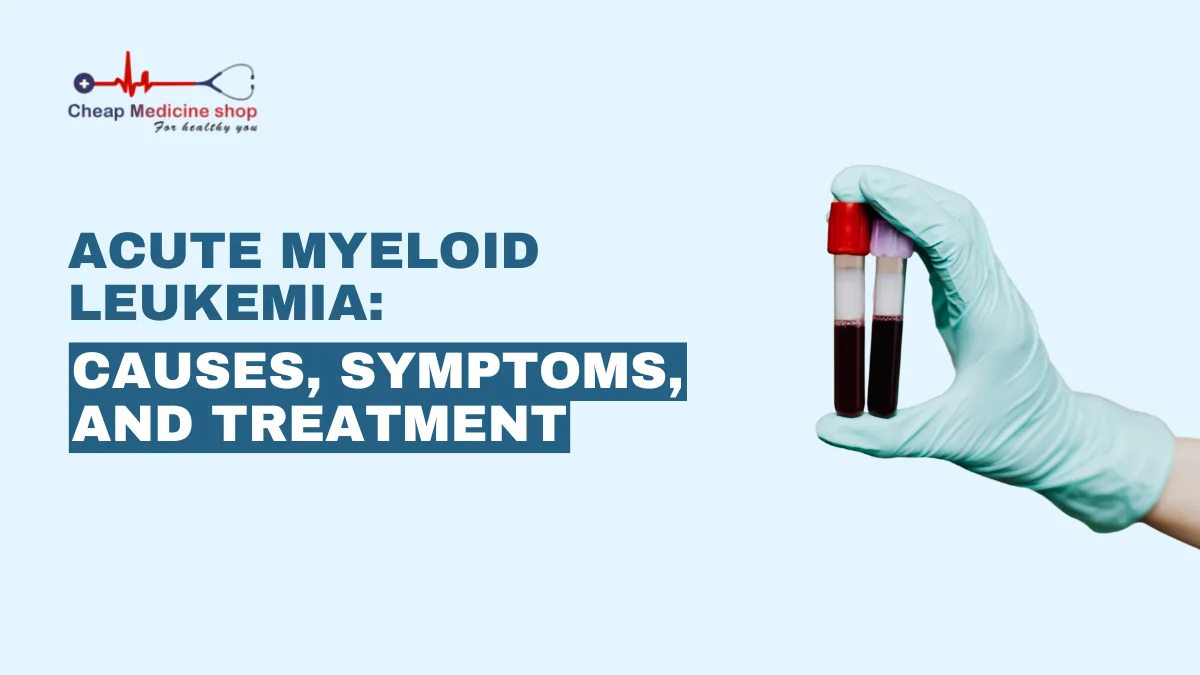Acute Myeloid Leukemia or AML is a fast-growing form of Cancer that starts in the bone marrow (the inner soft part of the bones), responsible for blood cell production. As a medical emergency, AML demands immediate diagnosis and treatment due to its aggressive nature.
Although it is most commonly seen in adults over the age of 60, AML can affect individuals of any age. With rising awareness about Blood Cancers, understanding AML, its warning signs, causes, diagnosis, and treatment options has become more important than ever.
This article offers a detailed look at AML to help readers understand the condition better and support early detection and timely care.
What is Acute Myeloid Leukemia?
AML is a form of Leukemia that affects the blood cells. The stem cells in the bone marrow convert into mature red blood cells, platelets, or white blood cells.
In AML, this process is disrupted. Immature white blood cells, known as Myeloblasts, multiply uncontrollably and outnumber healthy blood cells. These abnormal cells can not function properly, leading to serious complications like infection, Anemia, and bleeding.
The term acute refers to the disease’s rapid progression. Without treatment, AML can become life-threatening within weeks or months.
Save up to 90% on your medicine bills

Abraxane 100 Mg Injection

Alphalan 5 Mg Tablets

Adriamycin 50 Mg Injection

Abirapro 250 Mg Tablet
Types of AML
AML is a heterogeneous disease, meaning it has multiple subtypes depending on the genetic makeup of the Cancer cells and the specific blood cell line affected.
Some common subtypes include:
- AML with recurrent genetic abnormalities
- AML with myelodysplasia-related changes
- Therapy-related AML
- AML not otherwise specified (NOS)
Each subtype carries its own prognosis and may respond differently to treatment.
Causes and risk factors
The exact cause of AML is not always clear. However, researchers over the years have identified several risk factors that may contribute to its development:
- Genetic mutations: Some changes in the DNA of bone marrow cells can lead to AML. These mutations are usually acquired over a person’s lifetime rather than inherited.
- Exposure to radiation or chemicals: High levels of radiation (such as from atomic bomb exposure) or prolonged exposure to chemicals like benzene have been linked to AML.
- Previous chemotherapy or radiation: Cancer survivors who received certain types of chemotherapy or radiation therapy are at a more risk of developing secondary AML.
- Blood disorders: Conditions like Myelodysplastic Syndrome (MDS) or polycythemia vera can increase the risk of developing AML.
- Smoking: Cigarette smoke contains benzene and other harmful chemicals that have been associated with AML.
- Age and gender: AML is more common in older adults and occurs slightly more often in men than in women.
Signs and symptoms
Since AML affects the production of healthy blood cells, its symptoms can appear quickly and worsen rapidly. The Acute Myeloid Leukemia symptoms are similar to the general symptoms of Leukemia and include:
- Fatigue or weakness
- Frequent infections
- Easy bruising or bleeding
- Fever and night sweats
- Bone or joint pain
- Swollen lymph nodes, liver, or spleen
- Shortness of breath
- Pale skin
If any of these symptoms persist or worsen, prompt medical attention is essential.
Diagnosis of AML
The diagnostic process typically includes:
- Complete Blood Count (CBC): Abnormal levels of platelets, red blood cells or white blood cells may raise suspicion of Leukemia.
- Bone marrow aspiration and biopsy: These tests confirm the presence of leukemic cells in the bone marrow.
- Cytogenetic and molecular testing: These help identify genetic mutations or chromosomal abnormalities that influence treatment planning and prognosis.
- Lumbar puncture (Spinal Tap): Lumbar puncture is done to check if the Leukemia has spread to the central nervous system.
Early diagnosis allows doctors to initiate treatment promptly, which can significantly affect outcomes.
Treatment options for AML
Treatment for AML depends on factors such as the age of the patient, overall health, genetic mutations, and disease subtype. It typically involves two main phases:
- Induction therapy: This is the first stage of treatment to destroy as many Leukemia cells as possible and achieve remission. It often involves intensive chemotherapy.
- Consolidation therapy: Also called post-remission therapy, this phase targets remaining Cancer cells to prevent relapse. It may involve additional chemotherapy or stem cell transplantation.
Common treatment approaches
Treatment for AML includes a combination of strategies tailored to the patient’s specific diagnosis, age, and overall health. These include:
Chemotherapy
This is the most common form of treatment for AML. Acute Myeloid Leukemia medicines
like Cytarabine and Anthracyclines are typically used. While effective, chemotherapy can cause side effects such as hair loss, nausea, and a weak immune system.
Targeted therapy
Medicines are llike Midostaurin or Gilteritinib are used to block specific genetic mutations found in some AML patients. These therapies are often used alongside chemotherapy.
Stem cell transplant
Also known as bone marrow transplant, this involves replacing cancerous bone marrow with healthy stem cells from a donor. It is generally recommended for patients with high-risk AML or those who relapse after initial treatment.
Immunotherapy
Newer approaches like monoclonal antibodies or immune checkpoint inhibitors are being studied to help the body’s immune system fight AML.
Prognosis and survival rates
The Acute Myeloid Leukemia prognosis (course of a disease) for AML varies widely depending on age, subtype, genetic factors, and response to treatment. According to recent statistics:
- The 5-year survival rate for AML in adults above 60 years of age is approximately 10%, but this rate is higher in younger individuals at 50%.
- Patients with favorable genetic profiles and access to advanced treatments may have better outcomes.
- Early diagnosis and treatment initiation can significantly improve the prognosis.
Living with AML
Being diagnosed with AML can be overwhelming. The disease not only affects the body but also takes a toll on mental health. Supportive care is also an important part of the treatment plan and includes:
- Psychological counseling
- Nutritional support
- Infection prevention
- Pain management
- Physical therapy for recovery
Many Cancer centers also offer support groups where patients can share their experiences and find encouragement.
Ongoing research and clinical trials
Researchers around the world are constantly working to improve AML treatments and discover new ways to manage the disease. Current areas of focus include:
- Personalized medicine based on genetic mutations
- Immunotherapies like CAR T-cell therapy
- Combination therapies with fewer side effects
- New biomarkers for earlier detection
Patients can participate in clinical trials for access to cutting-edge treatments not yet widely available.
Prevention and risk reduction
While AML cannot be completely prevented, certain lifestyle changes and health practices may help reduce risk:
- Avoid exposure to harmful chemicals, especially in industrial settings.
- Quit smoking to lower the risk of benzene-related mutations.
- Regular medical check-ups for those with preexisting blood disorders.
- Genetic counseling for individuals with a family history of Blood Cancers.
Conclusion
Acute Myeloid Leukemia (AML) is a serious and rapidly progressing Blood Cancer that demands urgent medical attention. Its complex nature, ranging from diverse subtypes to varied causes and risk factors makes it a condition that requires both doctor’s advice and patient awareness. Early detection has an important role in improving outcomes, as timely diagnosis allows for prompt and potentially life-saving treatment.
Understanding the symptoms, recognizing risk factors, and being informed about the diagnostic and treatment processes can help individuals and families facing AML. Advances in chemotherapy, targeted therapies, stem cell transplants, and supportive care have improved survival rates over the years.
Staying informed, seeking timely medical advice, and maintaining a strong support system help in facing AML.

Frequently Asked Questions
Can Acute Myeloid Leukemia be misdiagnosed?
Yes, AML can sometimes be misdiagnosed in its early stages, especially when symptoms resemble those of other common illnesses like the flu, anemia, or chronic fatigue syndrome. This is why persistent or unexplained symptoms should always be investigated further through blood and bone marrow tests.
Is AML contagious or hereditary?
AML is not contagious and cannot be transmitted from one person to another. In most cases, AML is not inherited. However, rare genetic conditions like Fanconi anemia or Li-Fraumeni syndrome may increase the risk of developing AML in some families.
What is minimal residual disease (MRD) in AML?
MRD refers to a small number of Leukemia cells that remain in the body after treatment, even when no Cancer is detectable through standard tests. Detecting MRD through sensitive molecular testing helps predict the risk of relapse and guide further treatment.
Can diet or lifestyle changes help manage AML?
While diet and lifestyle cannot cure AML, a balanced diet, good hygiene, regular hydration, and infection prevention can support the body during and after treatment. Always consult with your care team before making any significant dietary changes.
Cheap Medicine Shop only refers to credible, authoritative sources for our content. If you’re curious about how we ensure the integrity of our content, we encourage you to read our Content Information Policy.














